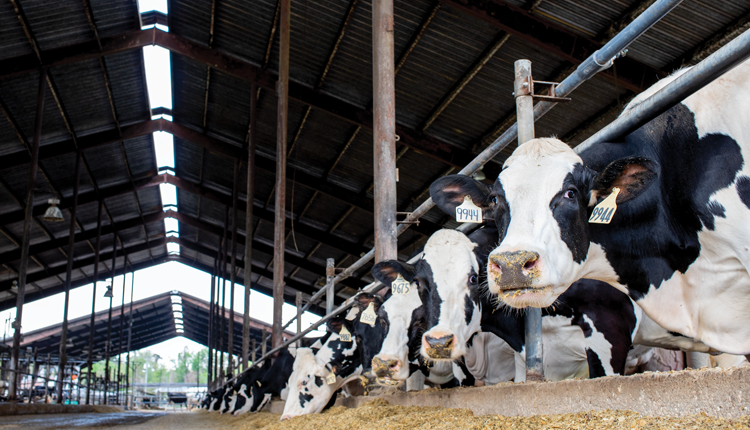
I recently read a research paper appropriate for the frosty winter weather many readers will be facing in the coming months about how feed and water temperature may affect rumen temperature and the significance of this. As I read it, I recalled years ago being interested in how cold water or frozen feed might negatively affect rumen function and fiber digestion.
At the Miner Institute dairy farm, frozen silage was commonly observed in the winter, and surely the water was icy cold, but we never did do any research. Still, the question was always there in the back of our mind — when cows consume cold feed and water, is there a productive penalty? Does all that cold material entering the rumen affect the microbes and their digestive function?
Fortunately, a paper published by Swiss researchers this year in the journal Animal identifies the relationships between drinking water temperature and rumen temperature, cow behavior, and feed efficiency. Here is my abbreviated take on their work and why it is important to think about how cold feed and water may affect your cows.
Cold stress management

At low temperatures, dairy efficiency drops as the cow directs more energy to maintenance of body temperature and away from milk production. Of course, high-producing cows have tremendous metabolic rates, and historically, much of our research and management focus has been on mitigating heat stress rather than cold stress.
The thermoneutral zone of lactating cows is about 40°F to 68°F, according to the National Academy of Science, Engineering, and Medicine. Body temperature usually falls between 100.4°F and 102.2°F. It is easy to see how frigid winter weather may push cows beyond their comfort zone.
Effects on the rumen
The researchers in this paper relied on boluses to monitor rumen temperature. They also correctly pointed out that rumen temperature is a good indicator of body temperature. Importantly, maintaining normal rumen temperature is necessary for desirable microbial digestion of feed. We know that drinking cold water can cause a dip in rumen temperature measured using boluses. These Swiss researchers focused on cold feed as well, though water had the largest negative effect.
During their study, they reported that drinking water varied from 36°F to 68°F. Rumen temperature fell by about 3°F per drinking bout, and it took between 10 and 160 minutes for rumen temperature to rebound. These time relationships are important, and we need more work of this nature to be done for cows of various production levels housed in different systems.
As the ambient temperature dropped below 51°F, dry matter intake crept up, but milk yield held steady. When ambient temperature and feed temperature were lower, cows ate larger meals. Based on these undesirable changes in feeding behavior and feed intake, we need to think about the potential consequences of large slugs of cold feed and water entering the rumen at once.
Similar to eating, cows had fewer bouts and drank less water at low temperatures, but the volume of each drink expanded markedly. Again, we need to ruminate on the potential negative impact of repeated slugs of cold water on the rumen microbial population.
Speaking of rumination, it was depressed with cold weather. Older research had also shown that cold water consumption reduces rumination, so these results make sense. Overall, the Swiss research group concluded that ambient temperatures below about 60°F result in consumption of water and feed cold enough to potentially alter eating, drinking, and ruminating behaviors. This is not an extraordinarily low air temperature, and these were lower producing cows, so we need more research to fully understand what happens to highly productive cows when exposed to cold winter temperatures. They may well tolerate lower air temperatures with less noticeable changes in behavior and feed intake.
Impacts on productivity
Cold weather and attendant changes in eating and drinking are associated with lower rumen temperature. The researchers observed lower dry matter intake, less water consumption, and a substantially lower feed efficiency (pounds of milk produced per pound of dry matter intake). Cows eating cold feed and drinking chilly water experienced more fluctuations in rumen temperature, presumably associated with the slugs of cold feed and water hitting the rumen environment with each meal or drink. As the authors pointed out, this variation in rumen temperature likely contributed to the compromised feed efficiency and greater energy cost of maintaining body temperature. In their study, the modeled efficiency of milk yield dropped by about 8% to 10% as ambient temperature fell from about 64°F to 39°F.
This research demonstrated that negative impacts of exposure to cold temperatures will worsen as the cow consumes feed and water that is substantially lower than body temperature. It is important to note that drinking cold water had a greater impact than cold feed. Because of this, production efficiency suffers and natural behaviors change.
Whether it would make economical sense to provide warmed water to cows under some conditions is an open question. This research made me think about whether we might be missing an opportunity to enhance performance during cold winter months. Again, it is worth noting that this work was done with later lactation, lower producing cows (approximately 55 pounds of milk per day). This topic warrants more research with high producing cows housed in modern freestall environments.
The next time you are in the barn on a chilly winter day and see cows at the water tank with vapor rising from their nostrils or you see cows at a feedbunk with chunks of frozen feed scattered through the mix, think about the potential consequences for the rumen. And for those readers where winters are warm, think about whether chilled water may be useful. That is a topic for another article in the new year!









